Fire Engineering: Analysis of Fire Safety Engineering Principles
VerifiedAdded on 2023/06/13
|9
|1008
|404
Homework Assignment
AI Summary
This Fire Engineering assignment solution covers essential aspects of fire safety engineering. It addresses the competencies required of a fire safety engineer, including evaluating fire safety statements and endorsing fire safety systems. The assignment identifies appropriate fire safety subsyst...
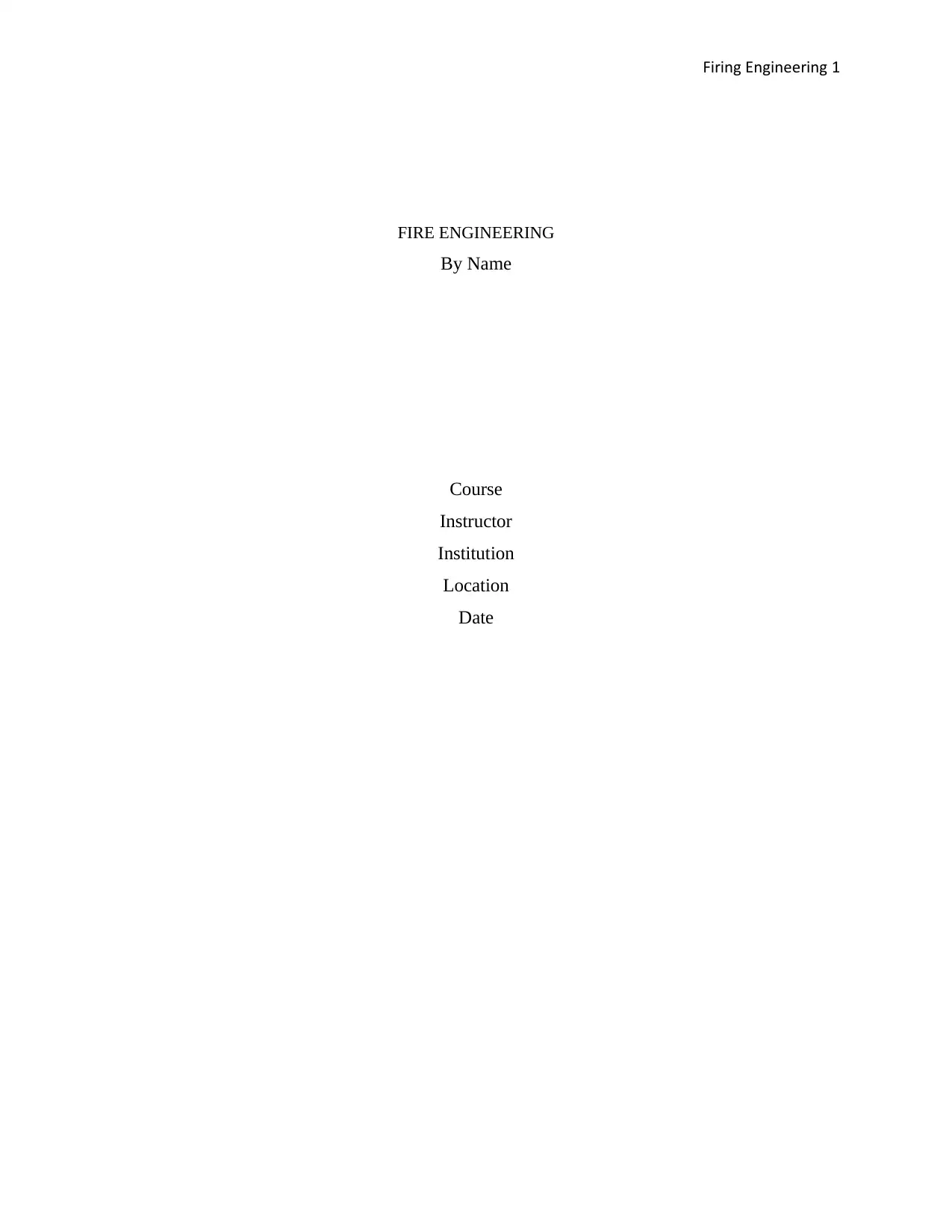
Firing Engineering 1
FIRE ENGINEERING
By Name
Course
Instructor
Institution
Location
Date
FIRE ENGINEERING
By Name
Course
Instructor
Institution
Location
Date
Paraphrase This Document
Need a fresh take? Get an instant paraphrase of this document with our AI Paraphraser
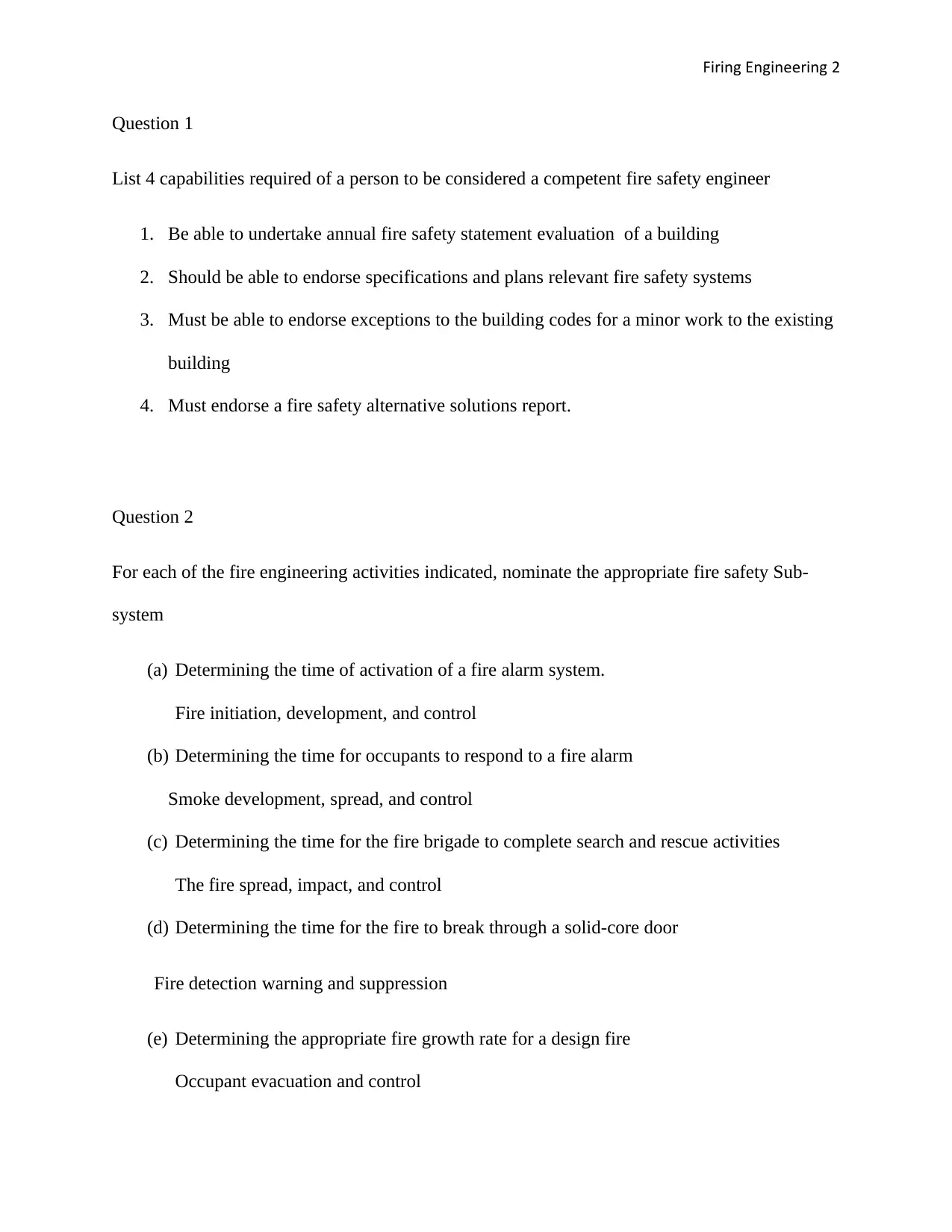
Firing Engineering 2
Question 1
List 4 capabilities required of a person to be considered a competent fire safety engineer
1. Be able to undertake annual fire safety statement evaluation of a building
2. Should be able to endorse specifications and plans relevant fire safety systems
3. Must be able to endorse exceptions to the building codes for a minor work to the existing
building
4. Must endorse a fire safety alternative solutions report.
Question 2
For each of the fire engineering activities indicated, nominate the appropriate fire safety Sub-
system
(a) Determining the time of activation of a fire alarm system.
Fire initiation, development, and control
(b) Determining the time for occupants to respond to a fire alarm
Smoke development, spread, and control
(c) Determining the time for the fire brigade to complete search and rescue activities
The fire spread, impact, and control
(d) Determining the time for the fire to break through a solid-core door
Fire detection warning and suppression
(e) Determining the appropriate fire growth rate for a design fire
Occupant evacuation and control
Question 1
List 4 capabilities required of a person to be considered a competent fire safety engineer
1. Be able to undertake annual fire safety statement evaluation of a building
2. Should be able to endorse specifications and plans relevant fire safety systems
3. Must be able to endorse exceptions to the building codes for a minor work to the existing
building
4. Must endorse a fire safety alternative solutions report.
Question 2
For each of the fire engineering activities indicated, nominate the appropriate fire safety Sub-
system
(a) Determining the time of activation of a fire alarm system.
Fire initiation, development, and control
(b) Determining the time for occupants to respond to a fire alarm
Smoke development, spread, and control
(c) Determining the time for the fire brigade to complete search and rescue activities
The fire spread, impact, and control
(d) Determining the time for the fire to break through a solid-core door
Fire detection warning and suppression
(e) Determining the appropriate fire growth rate for a design fire
Occupant evacuation and control
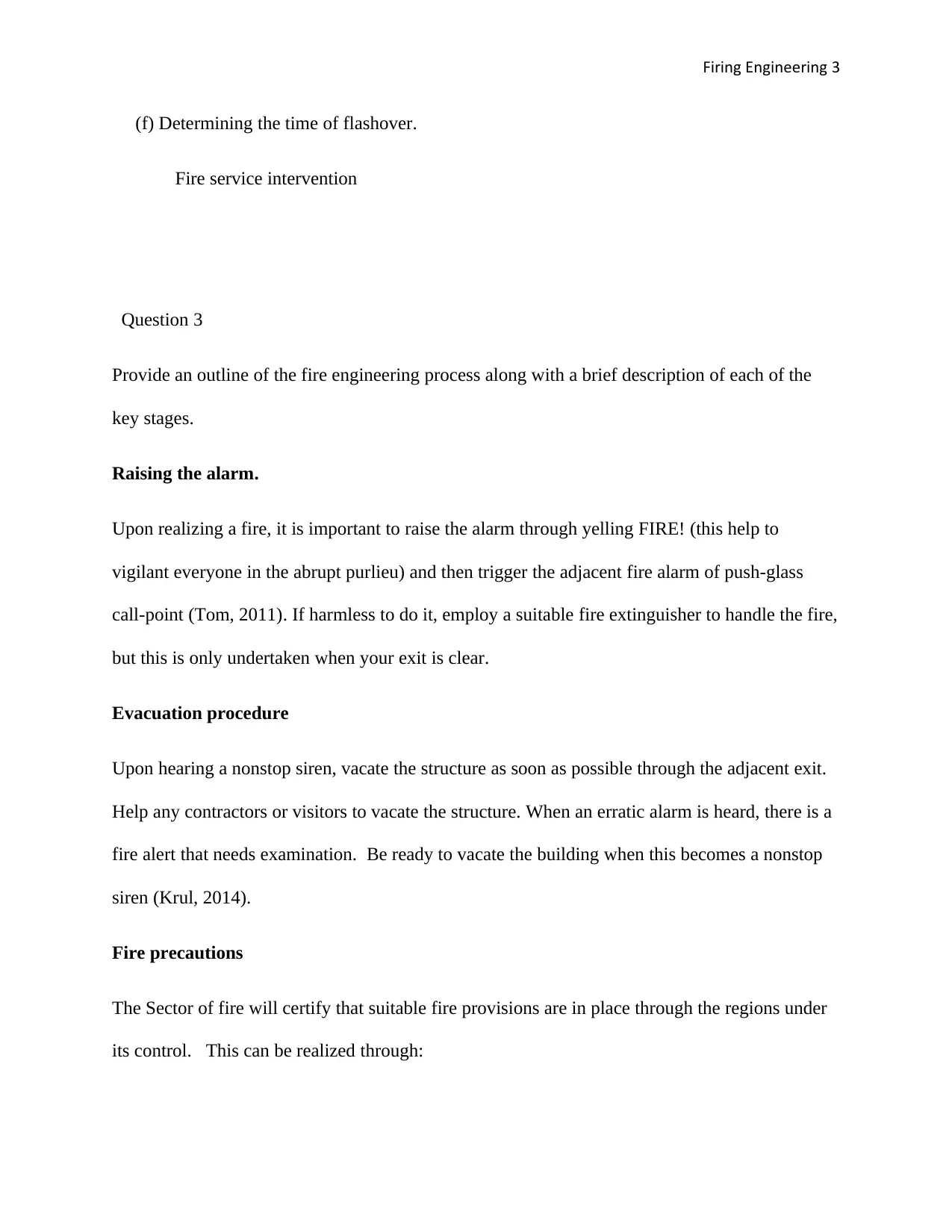
Firing Engineering 3
(f) Determining the time of flashover.
Fire service intervention
Question 3
Provide an outline of the fire engineering process along with a brief description of each of the
key stages.
Raising the alarm.
Upon realizing a fire, it is important to raise the alarm through yelling FIRE! (this help to
vigilant everyone in the abrupt purlieu) and then trigger the adjacent fire alarm of push-glass
call-point (Tom, 2011). If harmless to do it, employ a suitable fire extinguisher to handle the fire,
but this is only undertaken when your exit is clear.
Evacuation procedure
Upon hearing a nonstop siren, vacate the structure as soon as possible through the adjacent exit.
Help any contractors or visitors to vacate the structure. When an erratic alarm is heard, there is a
fire alert that needs examination. Be ready to vacate the building when this becomes a nonstop
siren (Krul, 2014).
Fire precautions
The Sector of fire will certify that suitable fire provisions are in place through the regions under
its control. This can be realized through:
(f) Determining the time of flashover.
Fire service intervention
Question 3
Provide an outline of the fire engineering process along with a brief description of each of the
key stages.
Raising the alarm.
Upon realizing a fire, it is important to raise the alarm through yelling FIRE! (this help to
vigilant everyone in the abrupt purlieu) and then trigger the adjacent fire alarm of push-glass
call-point (Tom, 2011). If harmless to do it, employ a suitable fire extinguisher to handle the fire,
but this is only undertaken when your exit is clear.
Evacuation procedure
Upon hearing a nonstop siren, vacate the structure as soon as possible through the adjacent exit.
Help any contractors or visitors to vacate the structure. When an erratic alarm is heard, there is a
fire alert that needs examination. Be ready to vacate the building when this becomes a nonstop
siren (Krul, 2014).
Fire precautions
The Sector of fire will certify that suitable fire provisions are in place through the regions under
its control. This can be realized through:
⊘ This is a preview!⊘
Do you want full access?
Subscribe today to unlock all pages.

Trusted by 1+ million students worldwide
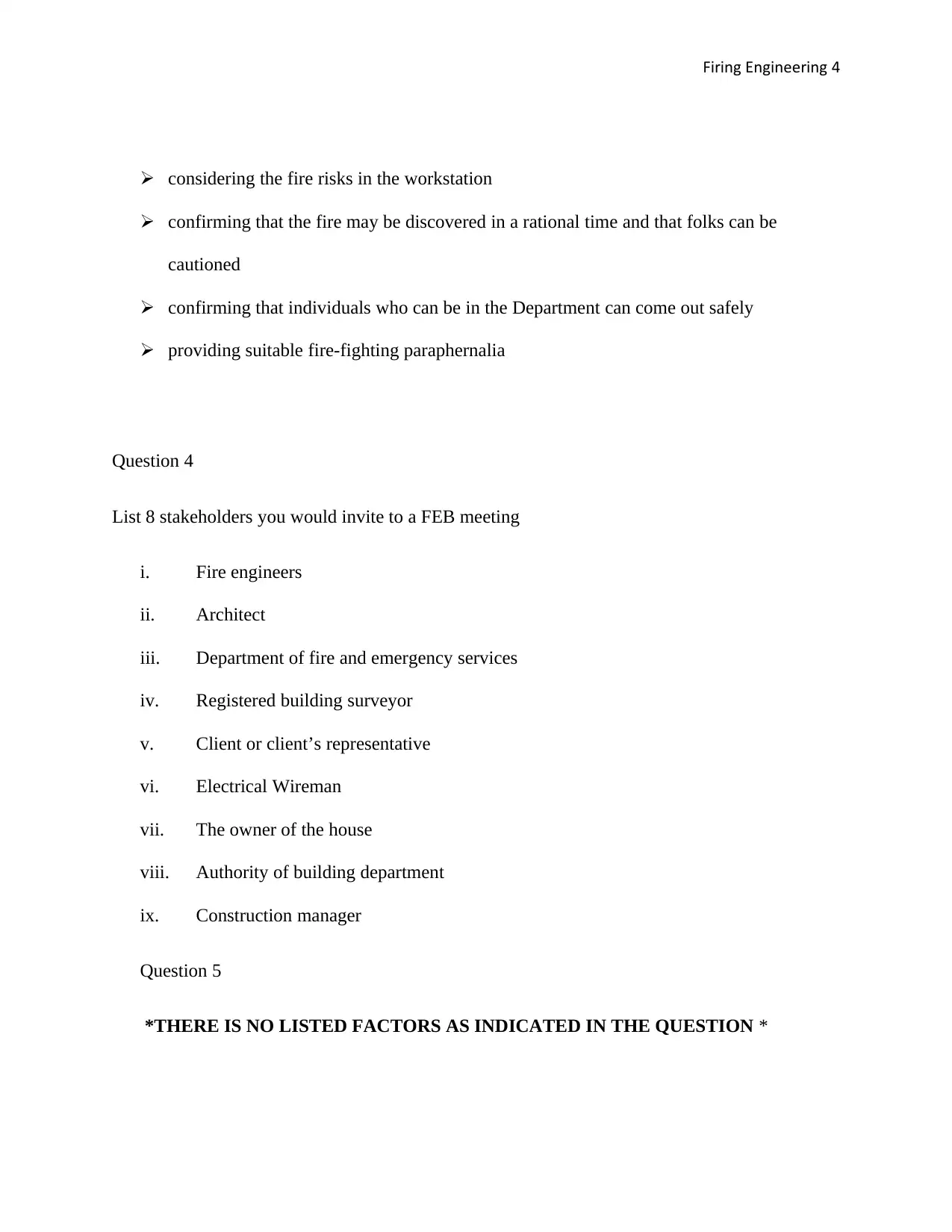
Firing Engineering 4
considering the fire risks in the workstation
confirming that the fire may be discovered in a rational time and that folks can be
cautioned
confirming that individuals who can be in the Department can come out safely
providing suitable fire-fighting paraphernalia
Question 4
List 8 stakeholders you would invite to a FEB meeting
i. Fire engineers
ii. Architect
iii. Department of fire and emergency services
iv. Registered building surveyor
v. Client or client’s representative
vi. Electrical Wireman
vii. The owner of the house
viii. Authority of building department
ix. Construction manager
Question 5
*THERE IS NO LISTED FACTORS AS INDICATED IN THE QUESTION *
considering the fire risks in the workstation
confirming that the fire may be discovered in a rational time and that folks can be
cautioned
confirming that individuals who can be in the Department can come out safely
providing suitable fire-fighting paraphernalia
Question 4
List 8 stakeholders you would invite to a FEB meeting
i. Fire engineers
ii. Architect
iii. Department of fire and emergency services
iv. Registered building surveyor
v. Client or client’s representative
vi. Electrical Wireman
vii. The owner of the house
viii. Authority of building department
ix. Construction manager
Question 5
*THERE IS NO LISTED FACTORS AS INDICATED IN THE QUESTION *
Paraphrase This Document
Need a fresh take? Get an instant paraphrase of this document with our AI Paraphraser
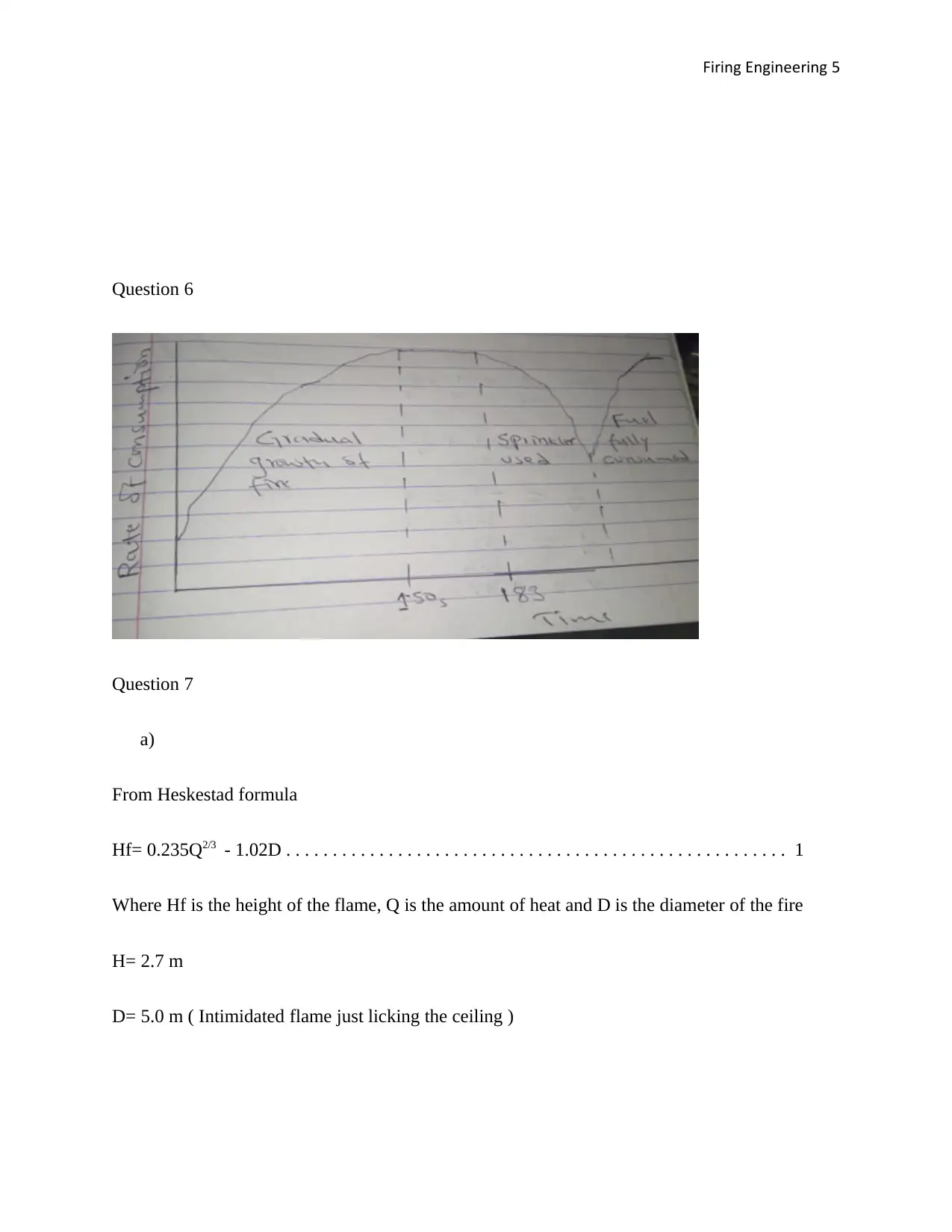
Firing Engineering 5
Question 6
Question 7
a)
From Heskestad formula
Hf= 0.235Q2/3 - 1.02D . . . . . . . . . . . . . . . . . . . . . . . . . . . . . . . . . . . . . . . . . . . . . . . . . . . . . . 1
Where Hf is the height of the flame, Q is the amount of heat and D is the diameter of the fire
H= 2.7 m
D= 5.0 m ( Intimidated flame just licking the ceiling )
Question 6
Question 7
a)
From Heskestad formula
Hf= 0.235Q2/3 - 1.02D . . . . . . . . . . . . . . . . . . . . . . . . . . . . . . . . . . . . . . . . . . . . . . . . . . . . . . 1
Where Hf is the height of the flame, Q is the amount of heat and D is the diameter of the fire
H= 2.7 m
D= 5.0 m ( Intimidated flame just licking the ceiling )
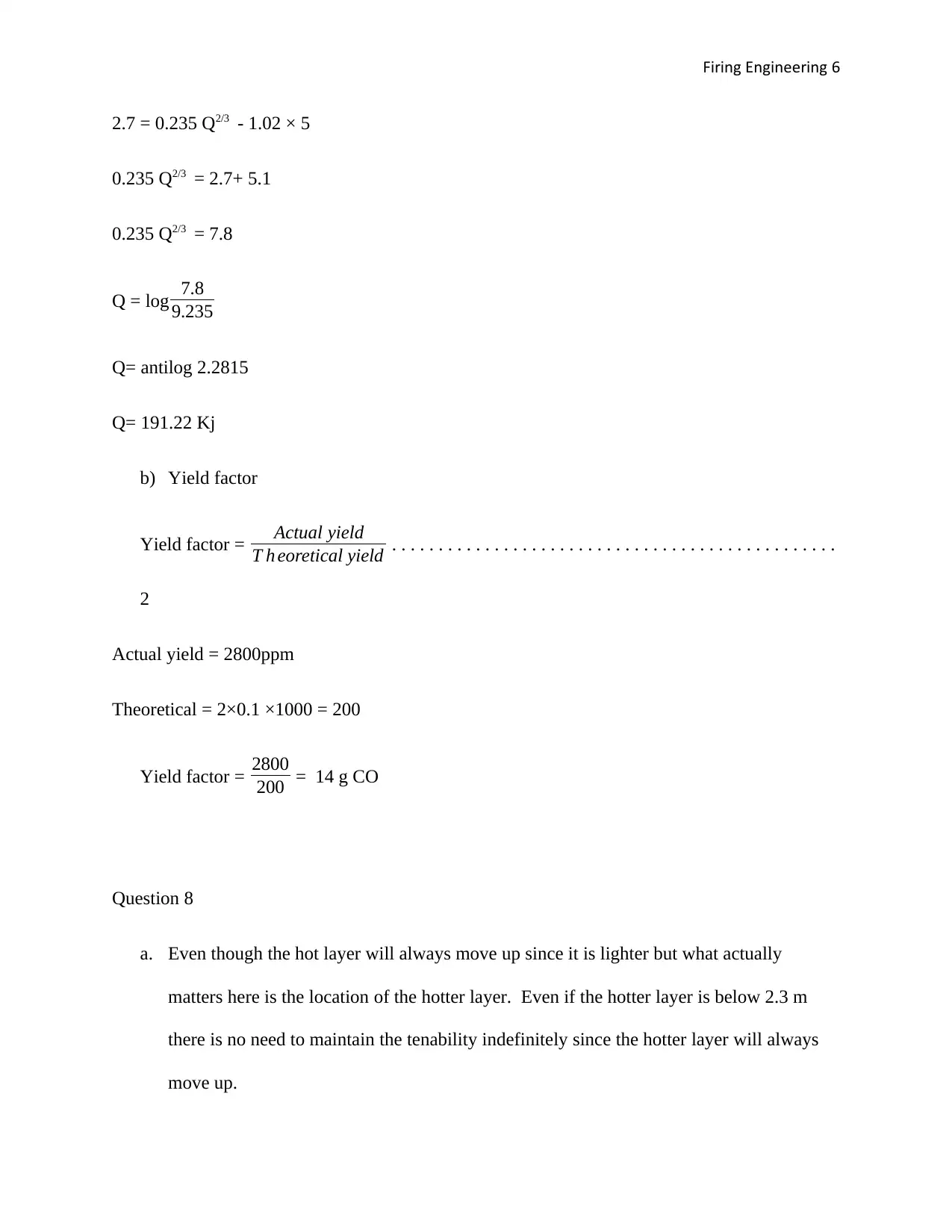
Firing Engineering 6
2.7 = 0.235 Q2/3 - 1.02 × 5
0.235 Q2/3 = 2.7+ 5.1
0.235 Q2/3 = 7.8
Q = log 7.8
9.235
Q= antilog 2.2815
Q= 191.22 Kj
b) Yield factor
Yield factor = Actual yield
T h eoretical yield . . . . . . . . . . . . . . . . . . . . . . . . . . . . . . . . . . . . . . . . . . . . . . . .
2
Actual yield = 2800ppm
Theoretical = 2×0.1 ×1000 = 200
Yield factor = 2800
200 = 14 g CO
Question 8
a. Even though the hot layer will always move up since it is lighter but what actually
matters here is the location of the hotter layer. Even if the hotter layer is below 2.3 m
there is no need to maintain the tenability indefinitely since the hotter layer will always
move up.
2.7 = 0.235 Q2/3 - 1.02 × 5
0.235 Q2/3 = 2.7+ 5.1
0.235 Q2/3 = 7.8
Q = log 7.8
9.235
Q= antilog 2.2815
Q= 191.22 Kj
b) Yield factor
Yield factor = Actual yield
T h eoretical yield . . . . . . . . . . . . . . . . . . . . . . . . . . . . . . . . . . . . . . . . . . . . . . . .
2
Actual yield = 2800ppm
Theoretical = 2×0.1 ×1000 = 200
Yield factor = 2800
200 = 14 g CO
Question 8
a. Even though the hot layer will always move up since it is lighter but what actually
matters here is the location of the hotter layer. Even if the hotter layer is below 2.3 m
there is no need to maintain the tenability indefinitely since the hotter layer will always
move up.
⊘ This is a preview!⊘
Do you want full access?
Subscribe today to unlock all pages.

Trusted by 1+ million students worldwide
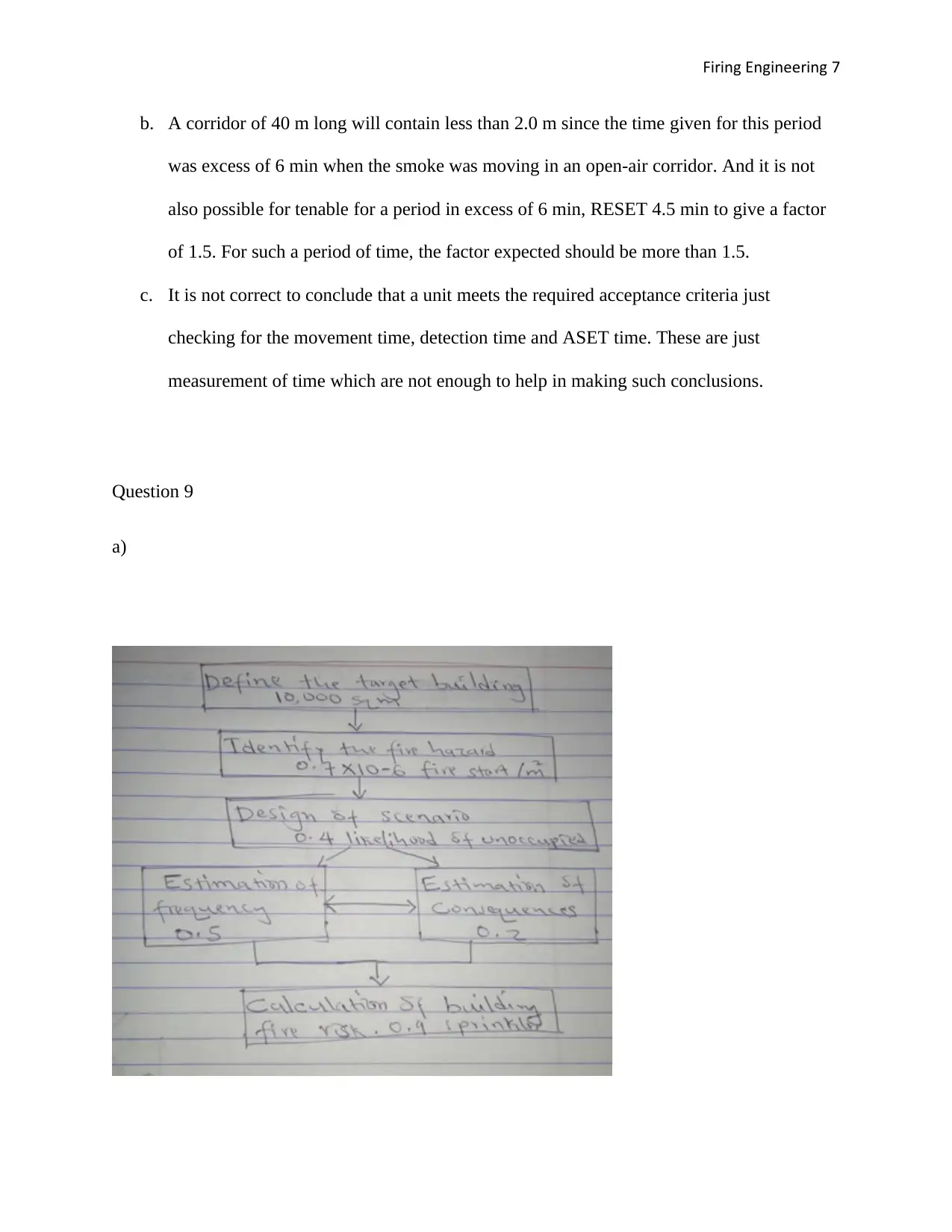
Firing Engineering 7
b. A corridor of 40 m long will contain less than 2.0 m since the time given for this period
was excess of 6 min when the smoke was moving in an open-air corridor. And it is not
also possible for tenable for a period in excess of 6 min, RESET 4.5 min to give a factor
of 1.5. For such a period of time, the factor expected should be more than 1.5.
c. It is not correct to conclude that a unit meets the required acceptance criteria just
checking for the movement time, detection time and ASET time. These are just
measurement of time which are not enough to help in making such conclusions.
Question 9
a)
b. A corridor of 40 m long will contain less than 2.0 m since the time given for this period
was excess of 6 min when the smoke was moving in an open-air corridor. And it is not
also possible for tenable for a period in excess of 6 min, RESET 4.5 min to give a factor
of 1.5. For such a period of time, the factor expected should be more than 1.5.
c. It is not correct to conclude that a unit meets the required acceptance criteria just
checking for the movement time, detection time and ASET time. These are just
measurement of time which are not enough to help in making such conclusions.
Question 9
a)
Paraphrase This Document
Need a fresh take? Get an instant paraphrase of this document with our AI Paraphraser
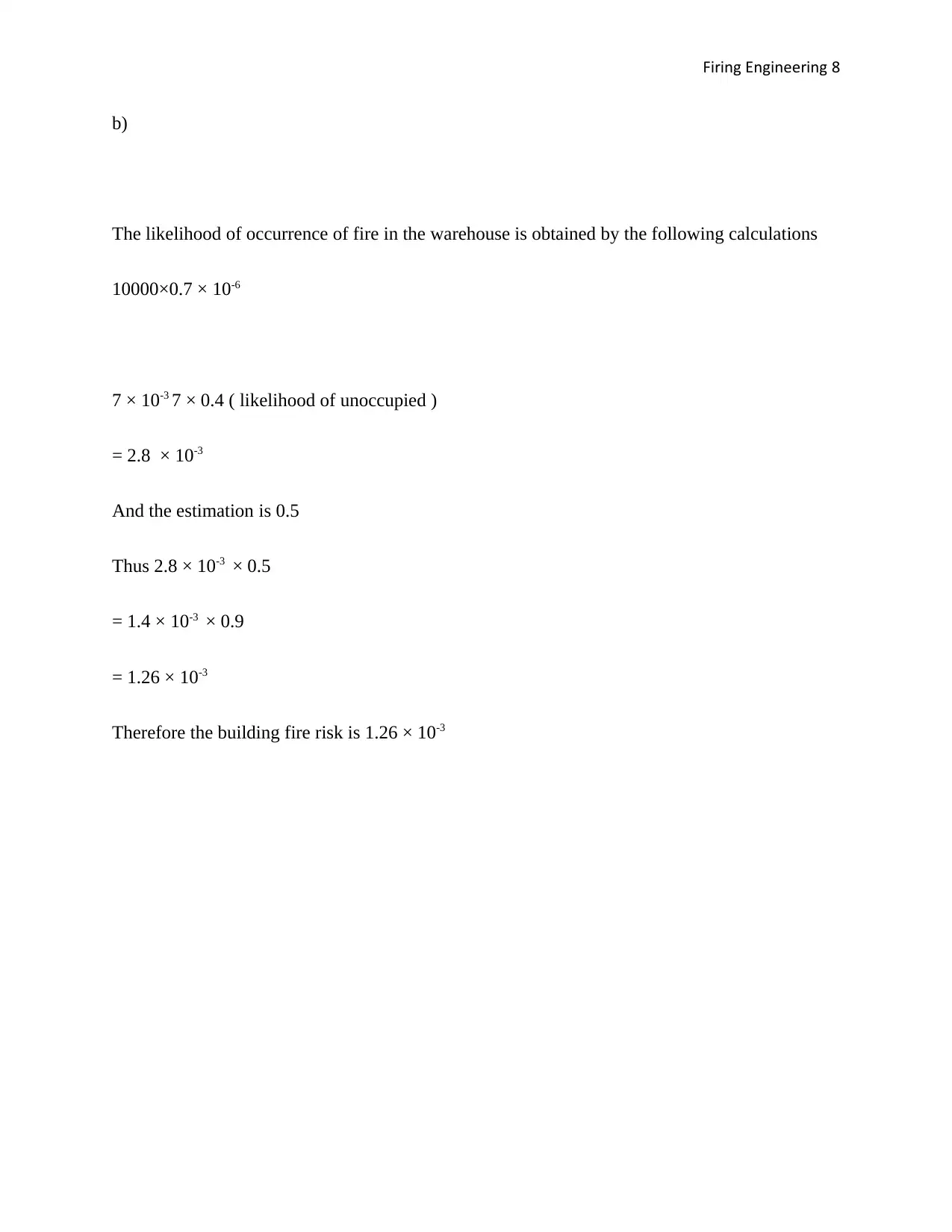
Firing Engineering 8
b)
The likelihood of occurrence of fire in the warehouse is obtained by the following calculations
10000×0.7 × 10-6
7 × 10-3 7 × 0.4 ( likelihood of unoccupied )
= 2.8 × 10-3
And the estimation is 0.5
Thus 2.8 × 10-3 × 0.5
= 1.4 × 10-3 × 0.9
= 1.26 × 10-3
Therefore the building fire risk is 1.26 × 10-3
b)
The likelihood of occurrence of fire in the warehouse is obtained by the following calculations
10000×0.7 × 10-6
7 × 10-3 7 × 0.4 ( likelihood of unoccupied )
= 2.8 × 10-3
And the estimation is 0.5
Thus 2.8 × 10-3 × 0.5
= 1.4 × 10-3 × 0.9
= 1.26 × 10-3
Therefore the building fire risk is 1.26 × 10-3

Firing Engineering 9
Bibliography
Krul, J., 2014.
Fire engineering : Management of fire. 2nd ed. Hull: CRC.
Tom, K., 2011.
Control of fire in a building. 1st ed. Chicago: Springer.
Bibliography
Krul, J., 2014.
Fire engineering : Management of fire. 2nd ed. Hull: CRC.
Tom, K., 2011.
Control of fire in a building. 1st ed. Chicago: Springer.
⊘ This is a preview!⊘
Do you want full access?
Subscribe today to unlock all pages.

Trusted by 1+ million students worldwide
1 out of 9
Your All-in-One AI-Powered Toolkit for Academic Success.
+13062052269
info@desklib.com
Available 24*7 on WhatsApp / Email
![[object Object]](/_next/static/media/star-bottom.7253800d.svg)
Unlock your academic potential
© 2024 | Zucol Services PVT LTD | All rights reserved.